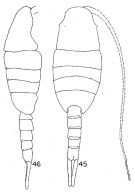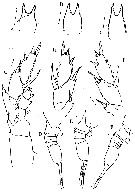|
|
 |
|
Calanoida ( Order ) |
|
|
|
Lucicutiidae ( Family ) |
|
|
|
Lucicutia ( Genus ) |
|
|
| |
Lucicutia bradyana Cleve, 1904 (F,M) | |
| | | | | | | Syn.: | Lucicutia flavicornis : Brady, 1883 (p.50, fig.F);
Lucicutia maxima : Wolfenden, 1911 (p.318, fig.);
Lucicutia rara Hülsemann, 1966 (p.735, Descr.M, figs.M, Rem.); Grice & Hulsemann, 1967 (p.18); Björnberg, 1973 (p.344, 387); Razouls & al., 2000 (p.343, tab. 3, Appendix);
Lucicutia grandis : Bradford-Grieve,1999 b (p.100, figs.F,M, Rem., figs.177, 191) | | | | Ref.: | | | Cleve, 1904 a (p.192, 204, Descr.F,M, Pl.VI: F,M); Sewell, 1948 (p.519, 540); Hülsemann, 1966 (p.704, 717, 719, 736); Boxshall & Halsey, 2004 (p.132: F, p.134: M); Markhaseva & Ferrari, 2005 (p.1084, figs.F,M, Rem.); Park & Ferrari, 2009 (p.143, Table 4, Appendix 1, biogeography from Southern Ocean) |  Issued from : K. Hülsemann in Bull. Mar. Sc., 1966, 16 (4). [p.714, Figs.45-46]. As Lucicutia rara. Male (from W Indian): 45, habitus (dorsal); 46, idem (lateral right side). Nota: Each side of head with one obtusely poited protrusion; in dorsal view, anterior margin truncate. Furca slightly longer than half the length of the abdomen, about six and one-half times longer than wide. Anal segment longer than preceding segment. Right A1 reaching enf of furca. 2nd basipodal segment of P1 with tube-like protrusion; endopod 3-segmented.
|
 Issued from : K. Hülsemann in Bull. Mar. Sc., 1966, 16 (4). [p.724, Fig.103]. As Lucicutia rara. Male from 26°24'S, 65°00'E): 103, P5. Nota: Each side of head with 1 obtusely pointed protrusion. In dorsal view, anterior margin truncate. Caudal rami slightly longer than abdomen, about six and one half times longer than wide. Anal segment longer than preceding segment. Right A1 reaching end of caudal rami. 2nd basipodal segment (Basis) of P1 with tube-like protrusion; endopod 3-segmented. Inner margin of Basis of right P5 expanded with small button in the middle; inner distal corner basis of left leg with strongly elongate toothed process.
|
 issued from : E.L. Markhaseva & F.D. Ferrari in J. Nat. Hist., 2005, 39 (15). [p.1085, Fig.3]. Female: A-B, habitus (dorsal; C, anterior part of cephalosome (lateral); D, posterior corners of prosome and urosome (dorsal). Scale bars: 0.1 mm. From South-western Pacific Ocean (37°31'S, 163°59'E): A. From Indian Ocean (31°20'S, 66°04'E): B. From SE Pacific Ocean (57°06'S, 78°04'W): C-D.
|
 issued from : E.L. Markhaseva & F.D. Ferrari in J. Nat. Hist., 2005, 39 (15). [p.1086, Fig.4]. Female: A-C, rostrum (anterior); D-F, posterior corners of prosome and urosome (lateral, right side); G, P5; H-I, 2nd and 3rd exopod segments of P5. Scale bars: 0.1 mm. From South-eastern Pacific Ocean (57°06'S, 78°56'W): A, F, H. From Indian Ocean (31°20'S, 66°04'E. From South-western Pacific Ocean (37°31'S, 163°59'E): C, D, I.
|
 issued from : E.L. Markhaseva & F.D. Ferrari in J. Nat. Hist., 2005, 39 (15). [p.1087, Fig.5]. Male: A-B, habitus (dorsal); C, rostrum (anterior); D, A1 (segments 14-16); E, A1 (segments 17-18); F, A1 (segments 19-21). Scale bars: 0.1 mm. From Indian Ocean (31°20'S, 66°04'E): A, C. From South-eastern Pacific Ocean (57°06'S, 78°56'W): B, D-F.
|
 issued from : E.L. Markhaseva & F.D. Ferrari in J. Nat. Hist., 2005, 39 (15). [p.1088, Fig.6]. Male: A-B, right and left P5 (specimen identified by Hulsemann, 1966 as L. rara, from Indian Ocean (29°29'S, 48°43'E); C-D, P5 (holotype of L. rara). Scale bars: 0.1 mm.
|
 issued from : E.L. Markhaseva & F.D. Ferrari in J. Nat. Hist., 2005, 39 (15). [p.1089, Fig.7]. Male: A1-C1, right P5; A2-C2, left P5. Scale bars: 0.1 mm. From Indian Ocean (31°39'S, 66°04'E): A1, A2; remaining figures, specimens from South-western Pacific Ocean (57°06'S, 78°56'W). Nota: The shape of the left and right basipod of male P5 distinguishes L. bradyana from L. grandis, but those shapes vary within a species. Among specimens studied is a male whose P5 (Fig.7 A2) is similar to that illustrated by Cleve (1904, Fig.34) in the original description. Despite this variability, the left basipod of all specimens has an elongate medially with teeth on the tip; right basipod has a distinct knob at mid-length.
| | | | | NZ: | 6 | | |
|
Distribution map of Lucicutia bradyana by geographical zones
|
| | | | | | | | | | Loc: | | | Antarctic (S Atlant., S Pacif.), S Atlantic, South Africa (E) (off Port Shepstone, Agulhas Current), Indian (SW & S), SW Pacif., S Chile (SW Cape Horn) | | | | N: | 6 | | | | Lg.: | | | (12) F: 5,7; M: 5,5; (21) M: 5,6-4,9; (909) F: 5-6,15; M: 4,7-5,45; (929) F: 5,5-6,1; M: 5,1-5,2; {F: 5-6,15; M: 4,70-5,50}
| | | | Rem.: | Bathypelagic.
The synonymy with Lucicutia rara is contested. For Hülsemann (1966, p.736) the male resembles L. grandis, longifurca and ushakovi in size and in the 3-segmented endopod of P1. It is distinguished from these species by its head armature combined with the long anal segment and the peculiar structure of P5. The species (raraL. bradyana Cleve which is doubtfully referred by Hülsemann to L. grandisSee remarks in Markhaseva & Ferrari (2005, p.1079, 1084, 1090) for Lucicutia grandis; for the authors it is a significant variability in P5 structure of males P5; shape of the left and right basipod of male P5 distinguishes L. bradyana from L. grandis, but those shapes vary within a species; despite this variability, the left basipod of all specimens of L. bradyana has an elongate projection medially with teeth on the tip; right basipod has a distinct knob at mid-length. The medial distal edge of the basipod of the left P5 of L. grandis has a saw-like, toothed margin; the medial edge of the basipod of the right P5 has a small bump. | | | Last update : 07/12/2020 | |
|
|
 Any use of this site for a publication will be mentioned with the following reference : Any use of this site for a publication will be mentioned with the following reference :
Razouls C., Desreumaux N., Kouwenberg J. and de Bovée F., 2005-2024. - Biodiversity of Marine Planktonic Copepods (morphology, geographical distribution and biological data). Sorbonne University, CNRS. Available at http://copepodes.obs-banyuls.fr/en [Accessed April 24, 2024] © copyright 2005-2024 Sorbonne University, CNRS
|
|
 |
 |










